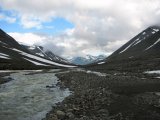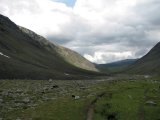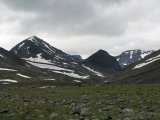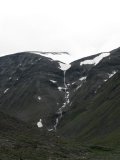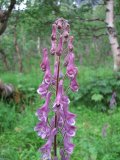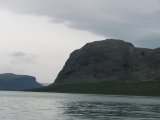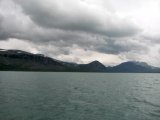Tuesday 31/7

This night was decidedly colder than any of the previous ones, and an addition of clothes was needed in the early morning. When I got up around 7 it was both windless and rainless, and a good deal of dense, low clouds were drifting about even though it seemed mostly clear above them. At first there was no visibility at all towards the inner valley, but even as I looked upon it the white wall started disintegrating. Breakfast was had in the open, and the various clouds lifted more and more by the minute, bringing a bit of sunlight at times which also raised the air temperature somewhat.
I was now set on continuing through the valley, having been encouraged by the more recent reports of the difficulty of the fords – or lack thereof. Should the Skájdásjvágge stream still prove too much for me there remained the option of passing through Skájdásjvágge itself, taking the high pass into Vássjávágge and then walk across the high plain of Jĺgĺsjgaskaláhko to Kungsleden – or simply look for a crossing place high(er) up the valley, and then return to Basstavágge.
I made an early start around 08:45, leaving the wind jacket in the pack for now. Indeed it was a bit warm at first, but soon the inevitable wind picked up and cooled things down appropriately. Despite being marked on the map as poorly defined, the path was pretty good except through some rock fields which were much more slippery than they looked. The frequency and size of snowfields upon the slopes increased steadily, and at one point there was an extensive snow bridge spanning Alep Basstajĺhkĺ, and since I would have to pass it sometime I saw no reason not to make use of this simple crossing. The terrain immediately on the other side consisted of sparse and stony grassland infused with both water and sand, and going was easy especially close to the stream.
As I approached Alep Basstajiegŋa the character of the land changed to hilly, and now that I was beginning to see the eastern parts of Basstavágge it was clear that clear was just what it was going to be in short fashion. In the watershed area I returned to the southern side of the valley, finding the ground to consist of fields of gravel and small rocks; while it was rather sterile and perhaps uninviting to the fastidious eye, it was still very easy to walk upon.
On a path which was only distinguishable in pieces I proceeded past Basstavárásj, that peculiar thorn-shaped formation that guards the center of the valley and which to the Sámi of old represented an enormous siejdde. This was usually a rock given extraordinary form by nature, and it marked a holy area under special protection that people could visit to ask for good fortune – often in conjunction with sacrifice. Probably as a consequence of the presence of Basstavárásj, at least in part, the Sámi have considered Basstavágge as a whole to be a valley of special significance and mystique, and during the reindeer migrations in the olden days it was customary for the noajdde – the Sámi equivalent of a shaman – to bring the ceremonial drum through it alone while the rest of the people circled Ähpár with the herds.
On my own solitary journey I saw the sky continue being liberated of cloud, and bringing my gaze down I saw the terrain again turn to hills between which it was not uncommon to find a snowfield or two. Suddenly I caught sight of another pair of hikers, who by the looks of it may also have been father and son, but they were walking closer to the new central stream that was forming and I don't think they observed me in turn. It was now sunny and nice, even though the clouds seemed to be clustering in the western parts of the valley instead, but that was no concern of mine.
Lulep Basstajĺhkĺ posed no problem either since there was an even larger snow bridge there, and after that the path was better. More clouds had started appearing from the southeast when I came to the notorious Skájdásjvágge stream, and a quick survey of the marked place where the path crossed it told me that a more suitable location would be preferable. The quartet from the Snávvávágge visit had related that when they came on the path from the other direction, they too had found the marked ford unsatisfactory and had instead gone over further downstream, so that's where I went as well. Close to the outflow of the stream into Lulep Basstajĺhkĺ I spotted a place where the water was somewhat calmer, and the depth was manageable too, so in I went.
The crossing was largely uncomplicated and felt safe all the way, with the water reaching to my kneecaps, although it was freezing – it was much colder than any of the other streams I had come across during the tour, and this isn't even a glacier stream. Having made it to the eastern side I had traversed the last major (potential) obstacle along the way, so I knew that the rest would be a cakewalk; it had not rained for perhaps 12 hours, but I can see how this stream can turn into a monster when given the chance. As my feet were going numb I sat down immediately on the other bank to have lunch, which was around 10:45.
While I sat there a good number of dense clouds took up position over Ähpár and then spread over larger celestial areas, soon hiding the sun. Before I departed I raised a cairn to mark my newly discovered ford, in case any wanderers that would come this way later on should have similar preferences as myself. On the pleasant grassland that followed the path was again very good, and when the land started sloping steeply into Lulep Basstajĺhkĺ it skirted the edge of the water. The passage of the stream that comes from high up Dágartjĺhkkĺ was a trifling matter, and after that the path went straight up the precipitous far side of that stream's ravine onto more grassland, upon which a large number of reindeer were grazing. Copses of osier began showing up, and some of them were on the verge of being bothersome.
I continued walking higher up as I exited Basstavágge, coming out on a flat, open area with a large boulder on it – this is a somewhat popular camping place, but one should exercise caution when using it thus since it is often subject to very strong winds, local wisdom says. Just there I saw another pair going in the opposite direction, coming from above, but seeing as how the path was good where I was (now fairly close to Lulep Basstajĺhkĺ) I continued upon it. I could now see more of the surrounding landscape, and in the general northern direction the clouds were much lower, even though there was still some clear sky in the far north (and the far east). I went on in calm and warm weather, finding the path fainter and fainter as the wetness of the ground increased.
Eventually I veered towards Dágartjĺhkkĺ and found a somewhat better path, but its quality varied as it continued southeastwards. After a rocky portion where there was no path at all I drifted outwards again, finding another (or the previous) path of similarly changing state. There were more osier and more wetness – often in conjunction – and the warmth was now pressing. It therefore came as a relief when a few gusts of air struck me on the last crest before the long slope towards the undisturbed Sijddojávrre started, and from there on the path was both well trodden and marked with simple cairns. Something else that had changed was a sharp increase in the number of mosquitos – something I hadn't had to worry about at all for a long time – so my repellant came in handy again. There was an easy ford at the start of the woodland, the vegetation of which was densely packed, and then I found myself at the modern-looking cottage of Per Kuhmunen in Rinim after 13:30.
Being an old Sámi encampment, Rinim now serves as the summer retreat of Kuhmunen and his family, who can usually be found there from around midsummer to the start of September, offering boat transfer to any who come by. At the moment there were only three kids and a dog there, however, but I was told that the rest would be back shortly. I walked down to the lake to have a look and then sat down in a chair outside the cottage and relaxed. When I dug up my phone to check if I could possibly get a signal already I found that not only was it on, but the battery was almost completely discharged – apparently I had managed to drop the rucksack onto the ground in such a way that the phone had been activated at some point, and since network stations are not to be found anywhere in or even near Sarek it had expended large amounts of energy in vain. Other than that it was nice and quiet, and not even the constant presence of all the buzzing mosquitos was annoying.
Eventually I heard the sound of a motorboat, and after it had landed I went down to the jetty. There I found Kuhmunen himself who was occupied with unloaded large containers of sand, and I helped out both with that task and with transferring the load up to the cottage. He then told me that he needed to recharge his own phone before we could leave for Kungsleden – for security reasons – and he would take this time to eat as well. I returned to my seat and read for a bit, and following another approach of a motor sound Kuhmunen's wife arrived carrying a can of freshly picked cloudberries. When their joint meal was over I paid up and Per and I readied ourselves for departure.
It had now started to get a bit chillier and the clouds that were everywhere looked much more ominous than before. Having made this run hundreds of times, Kuhmunen did not go needlessly easy on the accelerator handle, following a course marked by sticks through the shallow sections of the lake, which also brought us out of Sarek National Park. Apart from being a boat driver he is also somewhat famous among visitors to said park for being an interesting guide, and my experience was no different – during the journey he spoke of certain features around the large lake, and in the middle of it he brought out a huge antenna to take the bearing of a tagged reindeer he was keeping track of.
Around that time was when I first felt some light drops falling from the sky and shortly thereafter it developed into a drizzle – I was quite frankly surprised that it had held out for that long – and it was obviously raining more further ahead. We also took a detour to the southern shore to check out a curious green blob, which turned out to be a sleep mat which had lodged itself between some stones, and then we passed into Gasskajávrre and another stick course. This time, however, a sudden gust of wind interfered with the much more delicate maneuvering – it was very shallow, and the passable canal was very narrow – and caused the propeller to hit a rock. As a result the boat started to turn, and Kuhmunen had to use an oar to get it back on course – or, rather, a reversed course, and then back us out into deeper water. The rain had now intensified somewhat, but it was still fairly light, and the remaining distance to the Sitojaure cottages was short. At 16:30 I stepped onto the jetty, being greeted by the warden.
There were a large number of guests present already, but I got a room of my own – at least for the time being. I then spoke some with the warden; she had also heard stories of Skájdásjvágge and I provided her with up-to-date information. The main cottage was of a modern type and had a fresh feel to it, and I changed out of my damp clothes while most of the other guests ate in the kitchen, and then I had dinner too. More people had been dropping in, for after the meal I was asked to vacate the room and move in with another lone man who had also walked through Sarek, which none of us objected to, and a lengthy conversation of our respective experiences ensued. We then sat in the common room and talked with another couple of travellers while the rain fell steadily outside.
Later on the precipitation stopped and I went out for a bit, talking some more with the warden. As it turned out she and her partner were also newly examined wardens and this was their first assignment, so she suggested that I come in later to get a first-hand look at some practical things. In the meantime I had an evening snack, making it substantial now that I had only one day left. When I thought the time was ripe I went over to the warden's cottage where the three of us talked for a long time. This building, by the way, constitutes the most pure and inviting warden quarters I have seen so far, and I was a bit envious at them to have such living conditions. When I finally returned to the other cottage there was a light drizzle but visibility to the south was good. Inside my roommate had gone to bed but was not yet asleep, and I climbed into my own bunk at 22:30, dry and warm.









